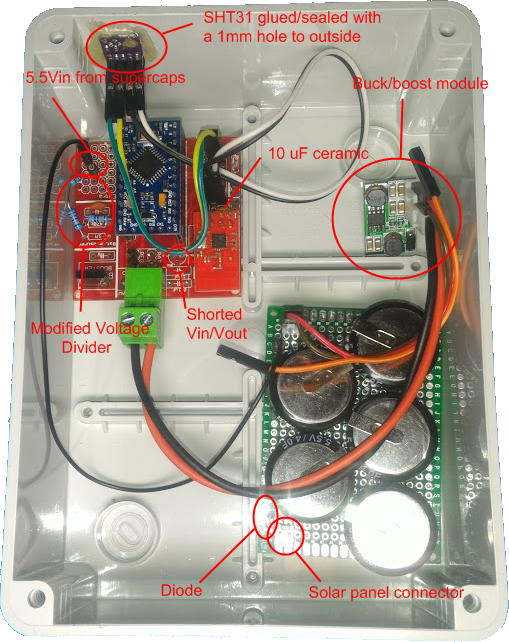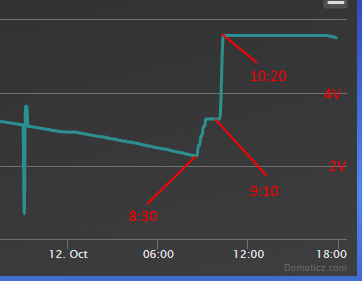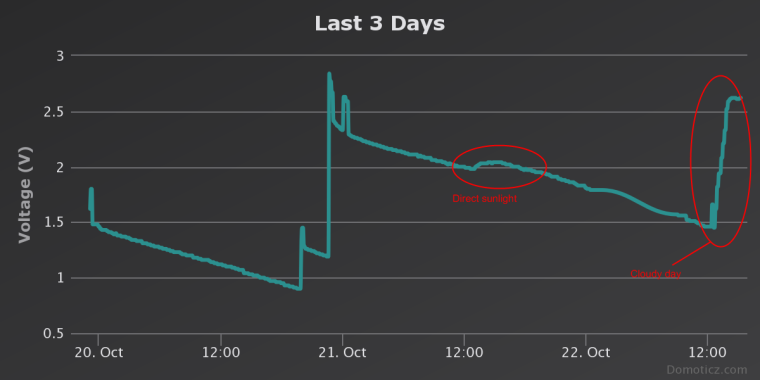Supercap Solar Powered Mysensors nodes as cheap as possible
-
I am currently testing a couple of concepts to power an outdoor node for temperature and humidity with readily available stuff:
-
2.7v: using this supercap + this module, just hook up any 6v solar panel to Vin and the supercap on the Vout with a diode in between that will block any reverse current and most important will drop voltage by ~0.7v to make it suitable for the supercap. Then I connected a standard EasyPCB from @sundberg84 with standard voltage divider, SHT31 sensor and this booster
-
5.5V: using 5 of theese connected directly to 6v solar panel with a diode in between for the above reasons, then connected them to the Vin of the buck-boost module and node connected to the Vout. This time I had to do some changes to EasyPcb: I shorted REG jumper, shorted Vin and Vout on the regulator footprint just above the Arduino and made a different voltage divider on the prototype area with R1 1.22M and R2 300K in order to read a maximum of 5.57v
((1e6+220e3+300e3)/300e3)*1.1 = Vmax = 5.57 Volts 5.57/1023 = Volts per bit = 0.0054480285.5V inside

Finished: the solar panel has been glued with transparent silicon for the entire perimeter

-
-

This is today test for the 5.5V setup: put the solar panel outside this morning at 8:30; I guess at ~10am it must have got direct sunlight. Tonight I'll move the solar panel not in direct sunlight to see how it will affect charging. Btw the 8:30 voltage is after 36 hours of no charge from full caps, sleep time 10 min. The spikes were made when I was reflashed the pro mini last night with a minor SW change
-
I am currently testing a couple of concepts to power an outdoor node for temperature and humidity with readily available stuff:
-
2.7v: using this supercap + this module, just hook up any 6v solar panel to Vin and the supercap on the Vout with a diode in between that will block any reverse current and most important will drop voltage by ~0.7v to make it suitable for the supercap. Then I connected a standard EasyPCB from @sundberg84 with standard voltage divider, SHT31 sensor and this booster
-
5.5V: using 5 of theese connected directly to 6v solar panel with a diode in between for the above reasons, then connected them to the Vin of the buck-boost module and node connected to the Vout. This time I had to do some changes to EasyPcb: I shorted REG jumper, shorted Vin and Vout on the regulator footprint just above the Arduino and made a different voltage divider on the prototype area with R1 1.22M and R2 300K in order to read a maximum of 5.57v
((1e6+220e3+300e3)/300e3)*1.1 = Vmax = 5.57 Volts 5.57/1023 = Volts per bit = 0.0054480285.5V inside

Finished: the solar panel has been glued with transparent silicon for the entire perimeter

@gohan said in Supercap Solar Powered Mysensors nodes as cheap as possible:
2.7v: using this supercap + this module, just hook up any 6v solar panel to Vin and the supercap on the Vout with a diode in between that will block any reverse current and most important will drop voltage by ~0.7v to make it suitable for the supercap.
FWIW, I've noticed quite a variance in the peak voltage produced by various 6v solar panels, even within the same model! I've had some that go as high as 7.5v in direct sunlight. Others never make it above 5.5v even in direct sunlight. Go figure. It's best to think of 6v as a purely nominal value.
-
-
I am currently testing a couple of concepts to power an outdoor node for temperature and humidity with readily available stuff:
-
2.7v: using this supercap + this module, just hook up any 6v solar panel to Vin and the supercap on the Vout with a diode in between that will block any reverse current and most important will drop voltage by ~0.7v to make it suitable for the supercap. Then I connected a standard EasyPCB from @sundberg84 with standard voltage divider, SHT31 sensor and this booster
-
5.5V: using 5 of theese connected directly to 6v solar panel with a diode in between for the above reasons, then connected them to the Vin of the buck-boost module and node connected to the Vout. This time I had to do some changes to EasyPcb: I shorted REG jumper, shorted Vin and Vout on the regulator footprint just above the Arduino and made a different voltage divider on the prototype area with R1 1.22M and R2 300K in order to read a maximum of 5.57v
((1e6+220e3+300e3)/300e3)*1.1 = Vmax = 5.57 Volts 5.57/1023 = Volts per bit = 0.0054480285.5V inside

Finished: the solar panel has been glued with transparent silicon for the entire perimeter

@gohan said in Supercap Solar Powered Mysensors nodes as cheap as possible:
2.7v: using this supercap
At least from what I've ready, I'm pretty sure you'll find the self discharge rate on that supercap to be very high.
-
-
In fact I'll do some more tests in the next days to see how much energy it can get vertically on the side of the wall, but I think I'll be heading on the 2.7v option. Maybe the crappy quality 100F Chinese supercap has an higher discharge rate, but after 3 days it is still at 1V and it has been sending 4 values every 10 minutes, so in my opinion it is a very reasonable result. In addition I'm not very convinced about the 5.5v supercaps since they are just 2 2.7v caps glued together, without any balancing, so for something that doesn't discharge to zero on a regular basis it will inevitably kill one of the 2 caps. Not to mention how much easier it is to handle a single big cap instead of soldering a bunch on some sort of pcb.
My biggest problem now it is more related in understanding why the voltage value I get from the A0 through the voltage divider is off +/- 0.3~0.5v. I checked with the multimeter and with a voltage divider calculator and I do get values within a very small error (resistors tolerances). For example on the 2.7v caps I'm reading 1V on multimeter and arduino reports 0.7v, while on the 5.5v caps I'm getting almost 0.5v more. I'm not sure what to look for. The code was from an example of @sundberg84 . Since on the 2.7v I'm running it on a steady 3.3v source (booster), maybe I could read the voltage directly from the A0 pin without voltage divider, or is it gonna kill the arduino?
-
In fact I'll do some more tests in the next days to see how much energy it can get vertically on the side of the wall, but I think I'll be heading on the 2.7v option. Maybe the crappy quality 100F Chinese supercap has an higher discharge rate, but after 3 days it is still at 1V and it has been sending 4 values every 10 minutes, so in my opinion it is a very reasonable result. In addition I'm not very convinced about the 5.5v supercaps since they are just 2 2.7v caps glued together, without any balancing, so for something that doesn't discharge to zero on a regular basis it will inevitably kill one of the 2 caps. Not to mention how much easier it is to handle a single big cap instead of soldering a bunch on some sort of pcb.
My biggest problem now it is more related in understanding why the voltage value I get from the A0 through the voltage divider is off +/- 0.3~0.5v. I checked with the multimeter and with a voltage divider calculator and I do get values within a very small error (resistors tolerances). For example on the 2.7v caps I'm reading 1V on multimeter and arduino reports 0.7v, while on the 5.5v caps I'm getting almost 0.5v more. I'm not sure what to look for. The code was from an example of @sundberg84 . Since on the 2.7v I'm running it on a steady 3.3v source (booster), maybe I could read the voltage directly from the A0 pin without voltage divider, or is it gonna kill the arduino?
@gohan said in Supercap Solar Powered Mysensors nodes as cheap as possible:
My biggest problem now it is more related in understanding why the voltage value I get from the A0 through the voltage divider is off +/- 0.3~0.5v. I checked with the multimeter and with a voltage divider calculator and I do get values within a very small error (resistors tolerances). For example on the 2.7v caps I'm reading 1V on multimeter and arduino reports 0.7v, while on the 5.5v caps I'm getting almost 0.5v more. I'm not sure what to look for. The code was from an example of @sundberg84 . Since on the 2.7v I'm running it on a steady 3.3v source (booster), maybe I could read the voltage directly from the A0 pin without voltage divider, or is it gonna kill the arduino?
IIRC, you shouldn't try to read a voltage that's higher than around 0.3v (or was it 0.6v?) more than VCC. Either way, if VCC is 3.3v, then 5.5 is well outside that range.
-
Since you're assuming access to direct sunlight, you can tolerate a lot of inefficiencies because of the overabundance of available energy compared to what most sensor nodes require. I remember one guy posted who had a similar 6v solar panel outdoors, and IIRC he said his 10F supercap was already fully recharged just from the daylight before sunrise. i.e. it's bright outside. So, even if your cheap 100F supercaps lose most of what they collect through high self discharge, but they collect a much larger amount all day long because of their higher capacity, maybe you come out ahead. Seems like a worthwhile experiment. Glad you're doing it.
-

Here is the graph of the voltage: the measurements started ok at ~2.6V but now it is showing 0.66V while I read 0.936V on multimeter I wonder what it may be. My knowledge in electronics is quite poor :sweat_smile:@gohan said in Supercap Solar Powered Mysensors nodes as cheap as possible:
I wonder what it may be.
I would guess the capacitor has a high internal resistance. Your multimeter doesn't see it unless the capacitor is under load. But your arduino is a load, so it sees it.
-
Maybe a schematic of your setup would help the readers of your thread make informed comments. Otherwise, it starts to become 20 questions, if you know what I mean. People on this forum love to look at schematics.
-
Maybe a schematic of your setup would help the readers of your thread make informed comments. Otherwise, it starts to become 20 questions, if you know what I mean. People on this forum love to look at schematics.
@NeverDie https://www.openhardware.io/view/389/EasyNewbie-PCB-RFM69-HWW-edition-for-MySensors "battery operation", I use this setup with the code like on this page https://www.mysensors.org/build/battery#measuring-and-reporting-battery-level
-
@NeverDie https://www.openhardware.io/view/389/EasyNewbie-PCB-RFM69-HWW-edition-for-MySensors "battery operation", I use this setup with the code like on this page https://www.mysensors.org/build/battery#measuring-and-reporting-battery-level
@gohan
Well, if 0.1uf is normally sufficient, why wouldn't it be in your case?There's an easy way to test my hypothesis: why don't you try powering your setup from some fresh batteries (or a high quality supercap if you have one) and see if there's still the voltage discrepancy? If not, then it's the ESR of your cheap supercap. If it's still there, then maybe you just need to calibrate?
-
@gohan said in Supercap Solar Powered Mysensors nodes as cheap as possible:
I have uploaded 2 pictures of the solar powered 5.5V node
Uploaded to where? I don't see anything.Nevermind, I see it now at the beginning of the thread. -
I'm currently testing the single 100F cap but it seems the buck boost is barely able to charge the supercap in direct sunlight, while the solar panel connected directly to the 5.5v supercaps was working much better. I'll have to try with a normal buck converter as it seems now the boost mode is making the solar panel working on a voltage too low that doesn't produce much power.
-
I replaced the buck-boost module with a simple buck converter and it seems to work much better since the operating voltage is from 4.5V to 23V. As you can see from the below picture, the buck-boost barely charged the cap while in direct sunlight while the buck converter was able to charge the cap in a short time even with a cloudy day.

I am also very happy since I set the output voltage to 2.62V on the buck converter and I actually get 2.62V reported by the arduino.
I also forgot to say that I am using a booster like showed in @sundberg84 project link text -
I replaced the buck-boost module with a simple buck converter and it seems to work much better since the operating voltage is from 4.5V to 23V. As you can see from the below picture, the buck-boost barely charged the cap while in direct sunlight while the buck converter was able to charge the cap in a short time even with a cloudy day.

I am also very happy since I set the output voltage to 2.62V on the buck converter and I actually get 2.62V reported by the arduino.
I also forgot to say that I am using a booster like showed in @sundberg84 project link text@gohan I suspect it's "working" because the voltage on your boost converter is higher than 2.62v from the solar panel anyway at the time that it's charging. Even on a cloudy day, it's not hard to get more than 2.6v on a 6v solar panel.
